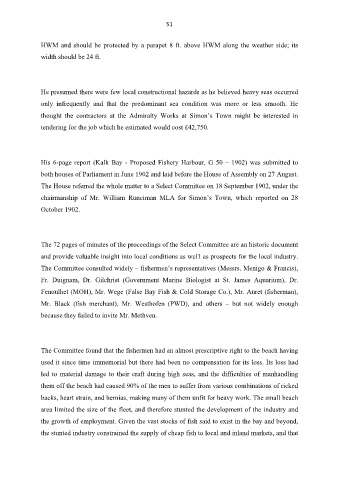Page 54 - Bulletin 18 2014
P. 54
51
HWM and should be protected by a parapet 8 ft. above HWM along the weather side; its
width should be 24 ft.
He presumed there were few local constructional hazards as he believed heavy seas occurred
only infrequently and that the predominant sea condition was more or less smooth. He
thought the contractors at the Admiralty Works at Simon’s Town might be interested in
tendering for the job which he estimated would cost £42,750.
His 6-page report (Kalk Bay - Proposed Fishery Harbour, G 50 – 1902) was submitted to
both houses of Parliament in June 1902 and laid before the House of Assembly on 27 August.
The House referred the whole matter to a Select Committee on 18 September 1902, under the
chairmanship of Mr. William Runciman MLA for Simon’s Town, which reported on 28
October 1902.
The 72 pages of minutes of the proceedings of the Select Committee are an historic document
and provide valuable insight into local conditions as wcl1 as prospects for the local industry.
The Committee consulted widely – fishermen’s representatives (Messrs. Menigo & Francis),
Fr. Duignam, Dr. Gilchrist (Government Marine Biologist at St. James Aquarium), Dr.
Fenoulhet (MOH), Mr. Wege (False Bay Fish & Cold Storage Co.), Mr. Auret (fisherman),
Mr. Black (fish merchant), Mr. Westhofen (PWD), and others – but not widely enough
because they failed to invite Mr. Methven.
The Committee found that the fishermen had an almost prescriptive right to the beach having
used it since time immemorial but there had been no compensation for its loss. Its loss had
led to material damage to their craft during high seas, and the difficulties of manhandling
them off the beach had caused 90% of the men to suffer from various combinations of ricked
backs, heart strain, and hernias, making many of them unfit for heavy work. The small beach
area limited the size of the fleet, and therefore stunted the development of the industry and
the growth of employment. Given the vast stocks of fish said to exist in the bay and beyond,
the stunted industry constrained the supply of cheap fish to local and inland markets, and that

